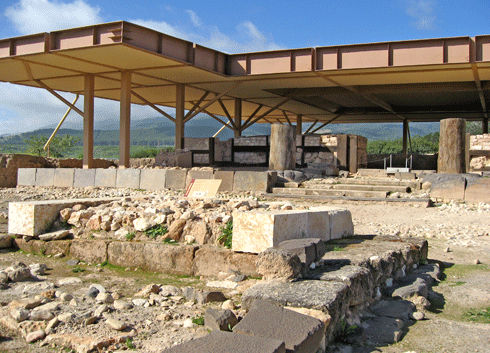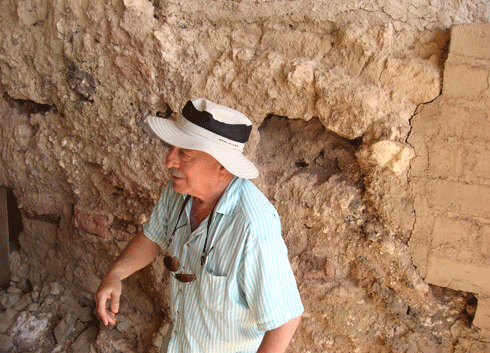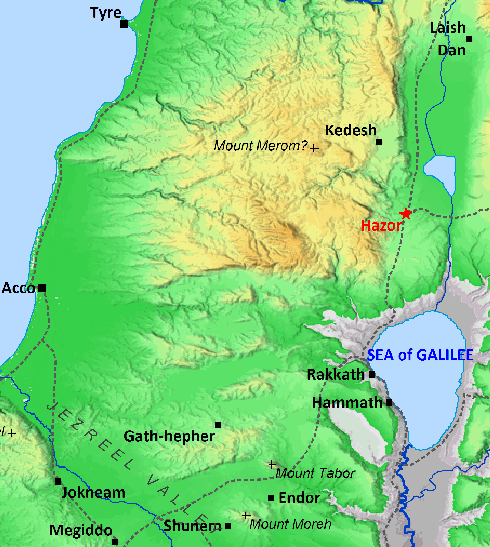|
 |
|
 |
| |
In Joshua’s
day, Hazor had about 20,000 residents.
It was like the London or Paris of the Land
of Canaan. In contrast, Jerusalem, 140
miles south, had a population one tenth the
size of Hazor.
Jabin, king of Hazor, like all his
predecessors, ruled from a magnificent
palace on the acropolis of the city.
His throne room had an imposing entrance
flanked by two huge cedar-of-Lebanon poles
standing on a base of quarried basalt stone,
each weighing four tons.
Jabin diligently organized a coalition of
northern Canaanite cities to block Joshua’s
advance. He had received a “twitter”
that Joshua had not only fought a battle at
Jericho where the walls came a-tumbling
down, but that he had commanded both the sun
and the moon to stand still for an entire
day.
The Book of Joshua (chapter 11 verse 13)
proclaims that of all the towns standing on
their mounds, Hazor was the only town Joshua
burnt. |
| |
Indeed,
archeologists discovered that Hazor was the
site of a fierce destruction. A fire
reaching 1300 degrees Celsius burned the
Canaanite palace. This is twice the
heat of an “ordinary” fire. The
intensity of the fire may be due to a
combination of olive oil stored in vessels
near the throne room and the many timbers of
cedar wood placed in the mud-brick walls and
on the floor of the palace. Add to
this, afternoon westerly winds ranging
between 50 to 60 miles an hour.
This combination of oil, timber and wind
created the very hot fire of 1300 degrees.
Excavators, working in a layer of ash up to
three feet thick, emerged from the palace as
if they had come straight out of a coal
mine! |
| |
|
 |
|
Photo:
Gila Yudkin |
|
Evidence of a fierce
destruction was found in this Canaanite
palace |
| |
| In the ruins of the burnt
palace, archeologists found ivory plaques,
cylinder seals, figurines, jewelry, and a
large basalt stone statue standing over
three feet tall. |
| |
|
 |
|
Photo:
Gila Yudkin |
|
Charred remains (on left)
of the mud-brick walls at Hazor's palace |
| |
| But what about Hazor’s National Library? Would the Israelites, being the People of
the Book, ransack the library and burn the
archives after hamstringing Jabin’s horses
and decimating his chariots? |
| |
| More than likely, the archives of King
Jabin’s predecessors (also called Jabin
which was a dynastic name, like King Louis
in France or King Henry in England) were
already buried, waiting for the
archeologists’ spade. |
| |
| In central Egypt letters written on clay
tablets from the king of Hatzor were found
by archeologists in an archive called the
el-Amarna letters. They are dated to the
14th century BC. The twenty-first century
equivalent of these clay tablets would be a
word document or an excel sheet on a CD. |
| |
We learn from these archives that the king
of Hazor was accused of conquering several
cities of the kings of Bashan (modern-day
Syria) and Tyre (Lebanon). The king of Hazor
was obviously a power-broker and one of the
few Canaanite rulers of
his day who called
himself “king” and was called so by others. |
| |
In the 1960s
a ten-year-old visiting the dig with his
parents picked up a broken bit of pottery
with triangular shaped cuneiform writing
(the script used in Mesopotamia). In
an interview forty years later, he claimed
that he realized immediately it was
“something”.
The tablet contained a Sumero-Akkadian
dictionary. (Akkadian was the language used
by nations of the Fertile Crescent for trade
and diplomacy, much as the internet is
dominated by English today.) This tablet
proves that there were scribes at Hazor and
it may have been composed by a scribe to
teach other scribes.
Another fragment, found by an American
tourist (on his honeymoon!), records a case
of litigation conducted in the presence of
the king concerning a dispute over real
estate at Hazor. Hazor, by the way, is one
of the few biblical sites where
identification has been confirmed by written
documents found on the site.
|
|
 |
|
Photo:
Gila Yudkin |
|
Perhaps under these Iron
Age ruins, the Bronze Age archive will be
found! |
|
|
| Hazor is mentioned several times in even
earlier documents found on the banks of the
Euphrates River, dated to the 18th century
BC. Hammurabi, king of Babylon, sent a
special ambassador to reside at Hazor. One
document mentions that Jabin, king of Hazor,
(Ibni-Adad in the Akkadian language)
received three shipments of 35 kilos of tin. Tin alloy was crucial for the production of
bronze weapons. (Tin may be the 18th century
BC equivalent of enriched uranium!) |
| |
|
Two summers in a row, chief
archeologist Amnon Ben Tor showed my Texas
groups where he expects to find Hazor’s
archives. Volunteers from 27 countries were
digging strata from the 8th century BC with
the tops of pillars from the 9th century BC
poking out of the earth. During the next
season they will reach the Solomonic strata
(tenth century BC). And eventually in the
layer of debris from the fourteenth century
of the Canaanite period, they hope to find
the tablet treasure testifying to Hazor’s
era of glory. |
| |
|
 |
|
Photo:
Gila Yudkin |
|
Chief archeologist Amnon Ben Tor in the
ruins of the burnt Canaanite palace |
|
|
Ben Tor’s enthusiasm is infectious. Chief
excavator since 1990, Ben Tor had
participated as a student in Yigael Yadin’s
excavation in the 1950s. He told us that
15
marriages were initiated at Hazor, including
his own! |
| |
|
The dig at Hazor is super exciting. The
discovery of an archive dating from the
patriarchal era or the period of Joshua’s
conquest could ignite a heated scholarly
debate, particularly if it seems to confirm
or contradict the biblical narrative.
Stay tuned! |
| |
|
 |
|
Copyright
2012 by Gila Yudkin |
|
Hazor dominated the
international highway heading north and east
to Damascus |
| |
|
Copyright 2010, 2012 Gila Yudkin. Permission
needed for any reuse. |
| |

